Menu Engineering and Dietary Behavior Impact on Young Adults’ Kilocalorie Choice
Abstract
1. Introduction
2. Materials and Methods
3. Results
3.1. Demographics
3.2. Restaurant-Type
3.3. Menu Design and Calorie Choice
3.4. Stages of Change and Calorie Choice
3.5. Demographics and Calorie Choice
3.6. Degree of Hunger and Calorie Choice
4. Discussion
5. Conclusions
Author Contributions
Funding
Institutional Review Board Statement
Informed Consent Statement
Data Availability Statement
Acknowledgments
Conflicts of Interest
Appendix A
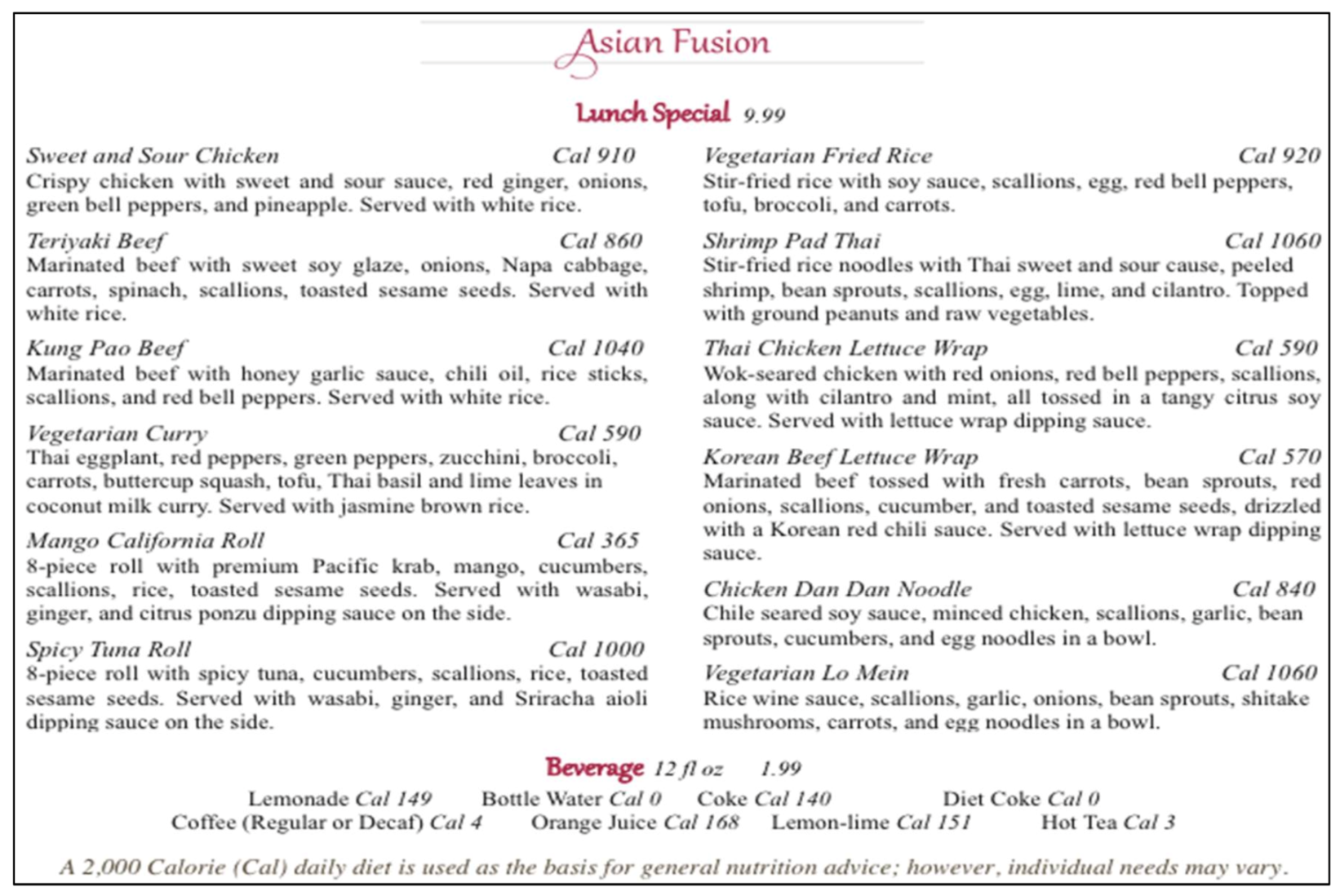
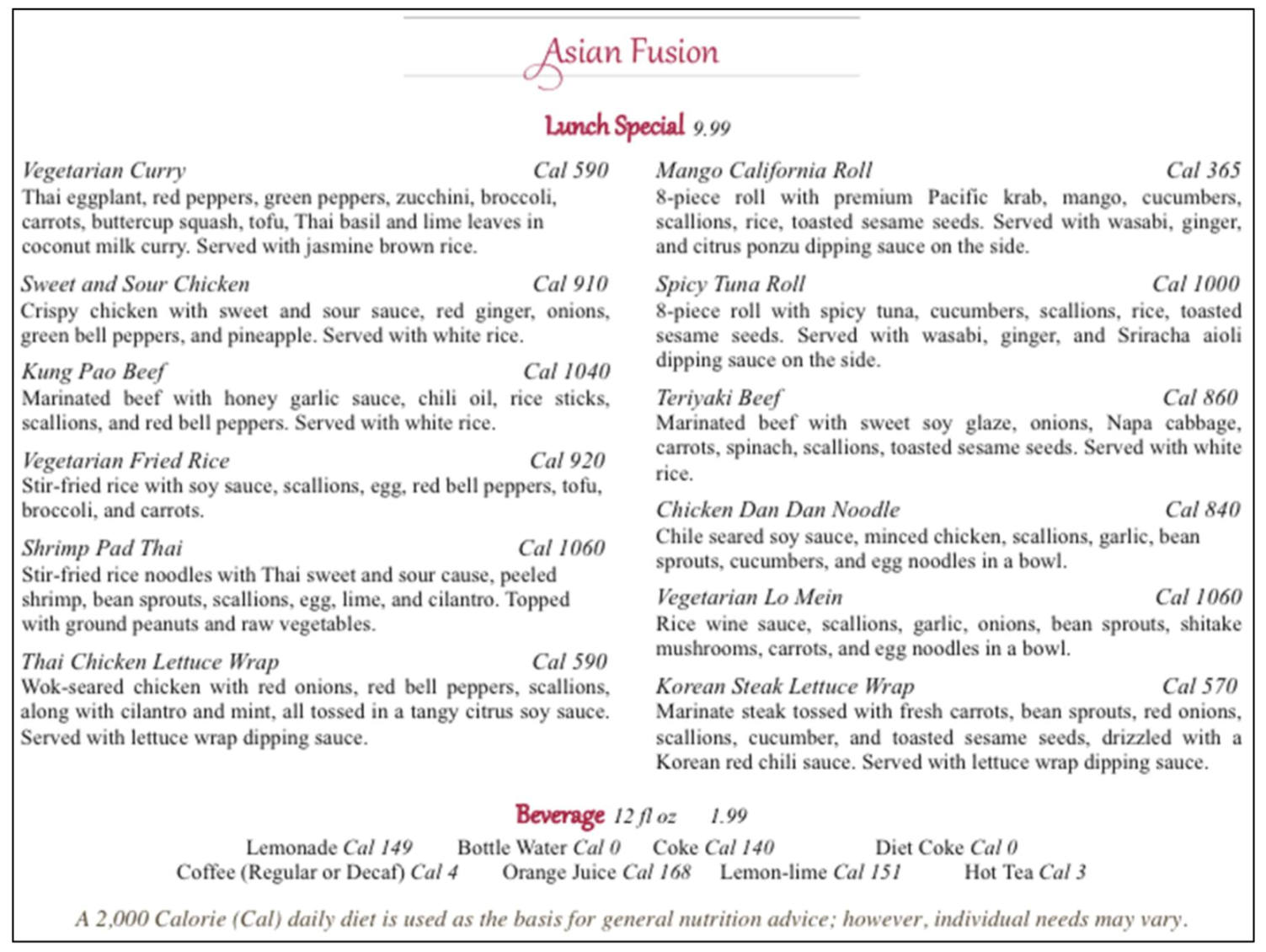
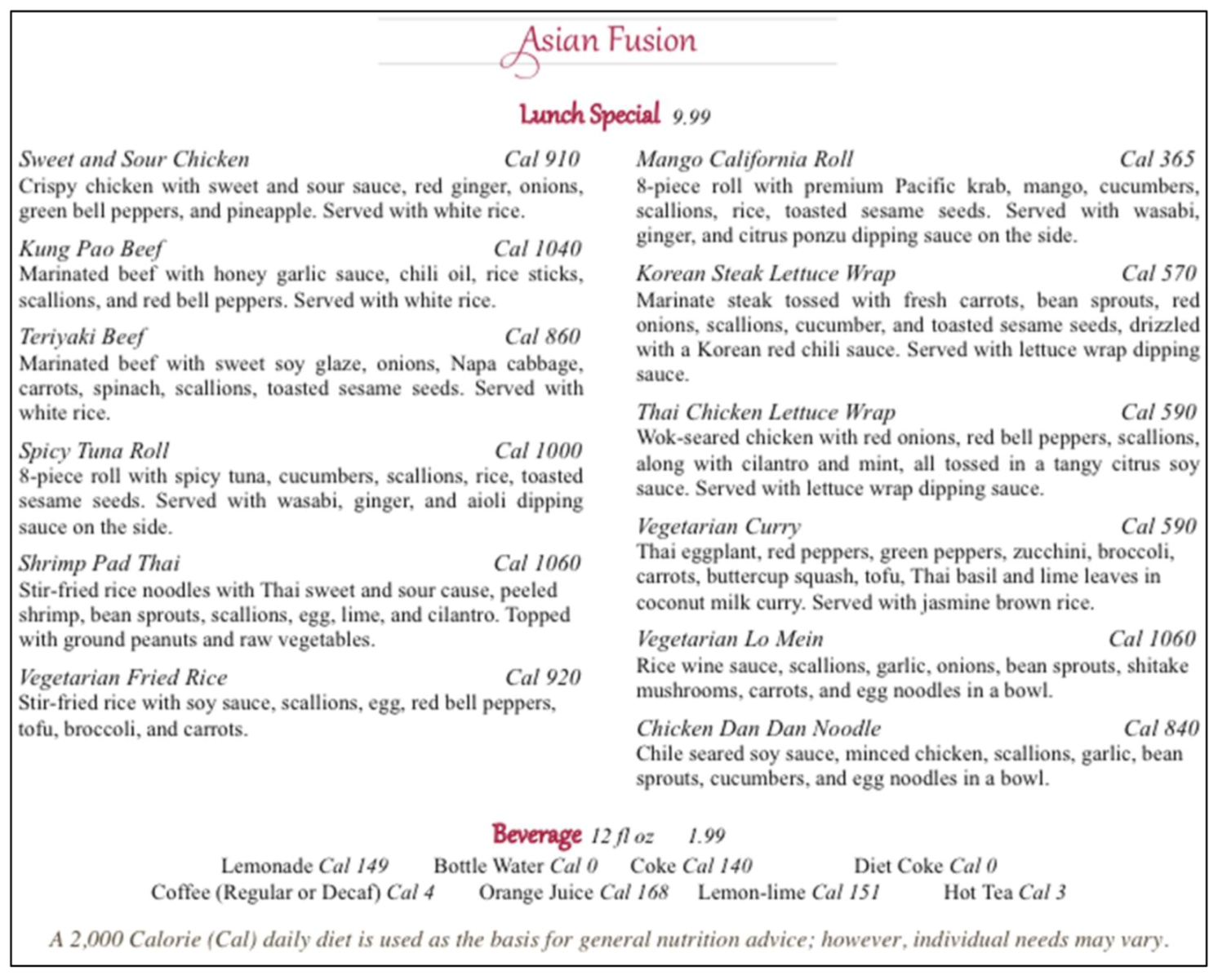
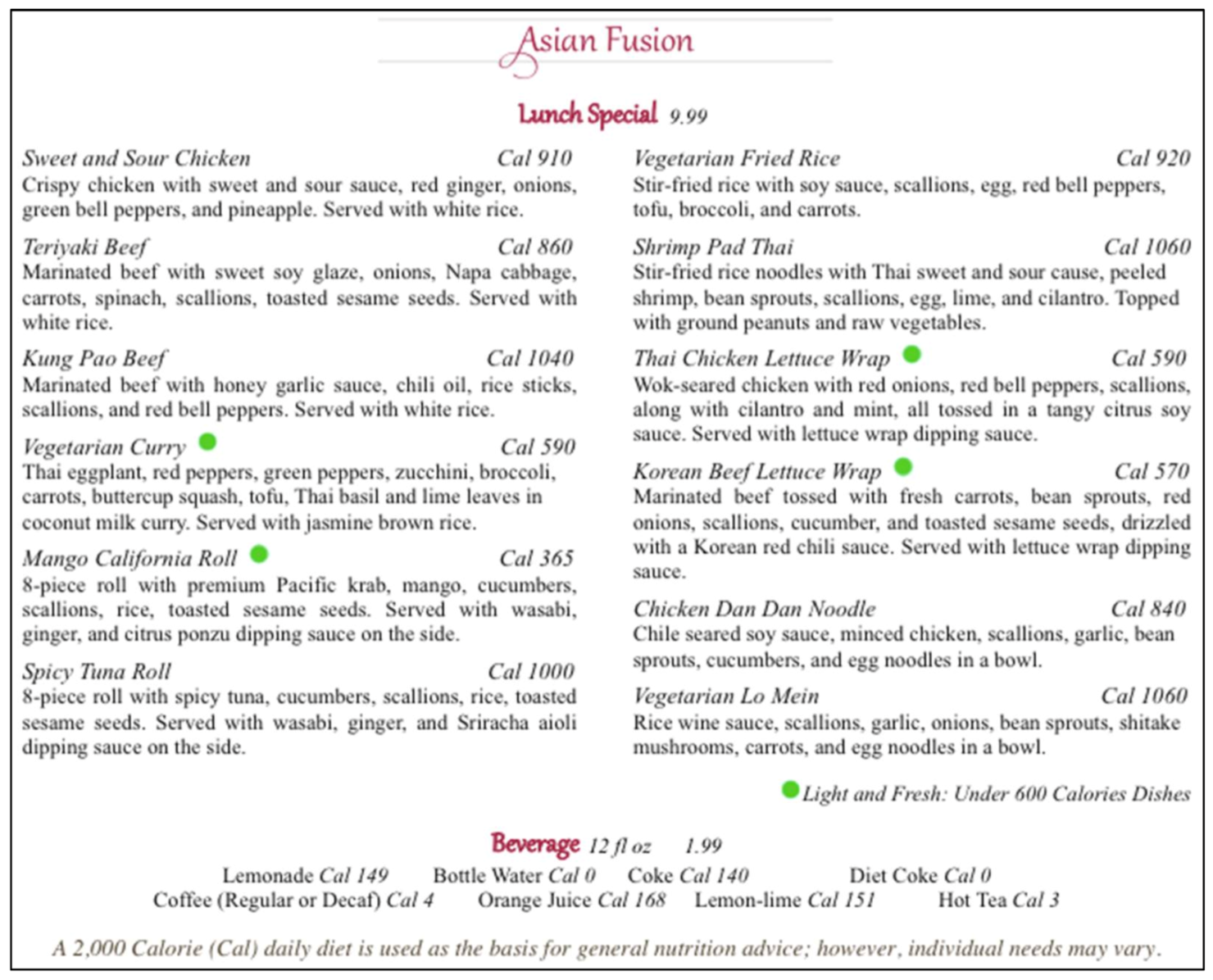
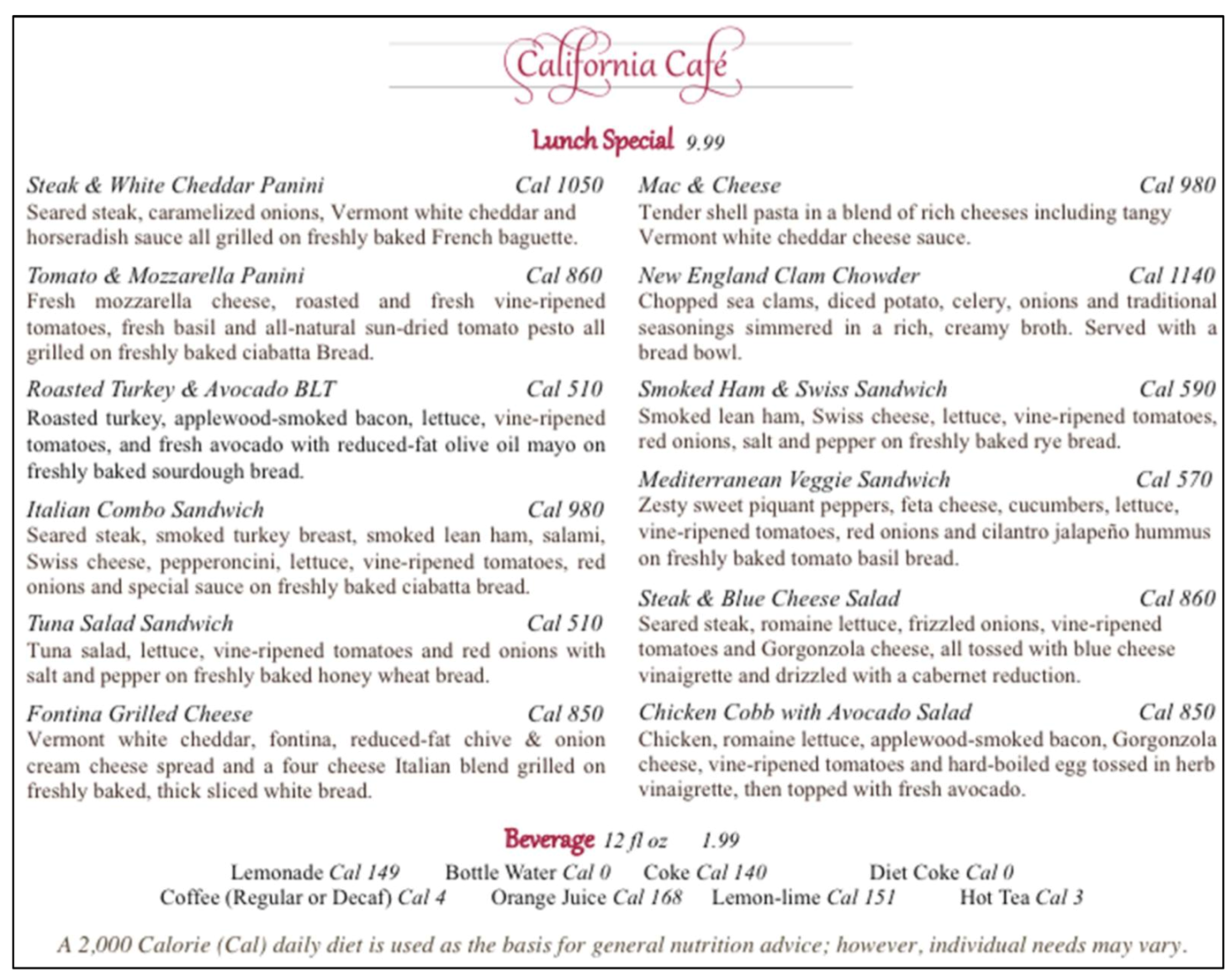
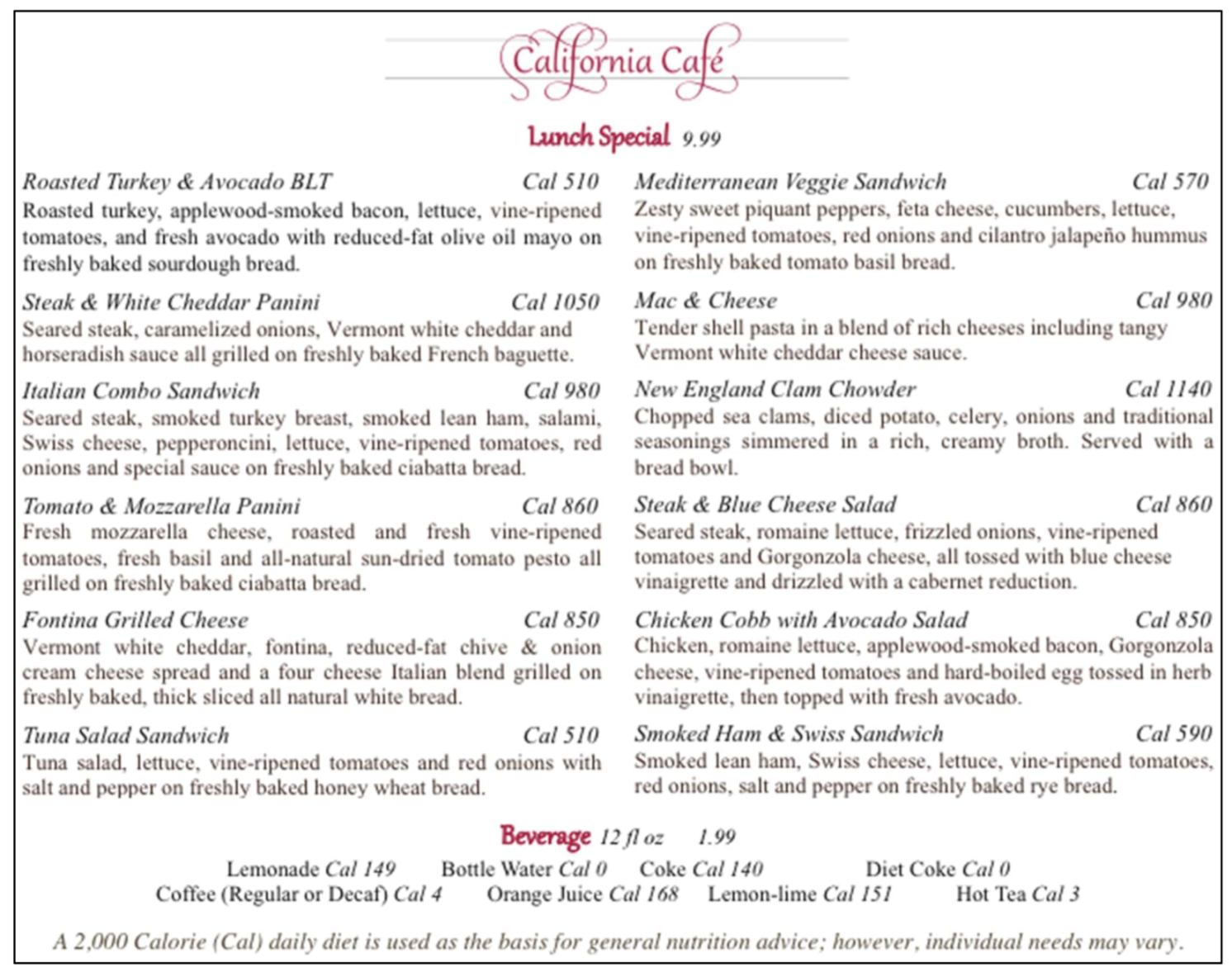
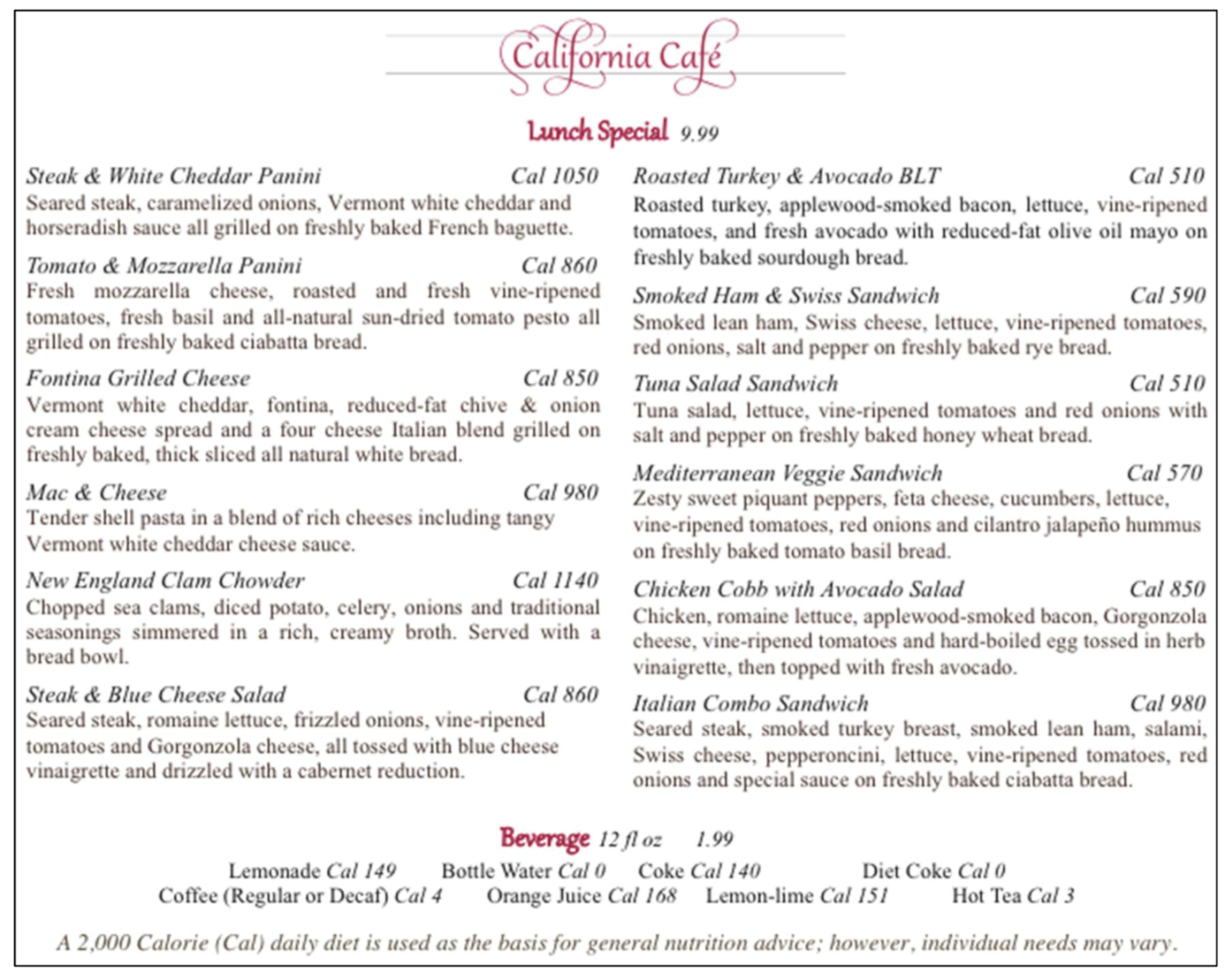
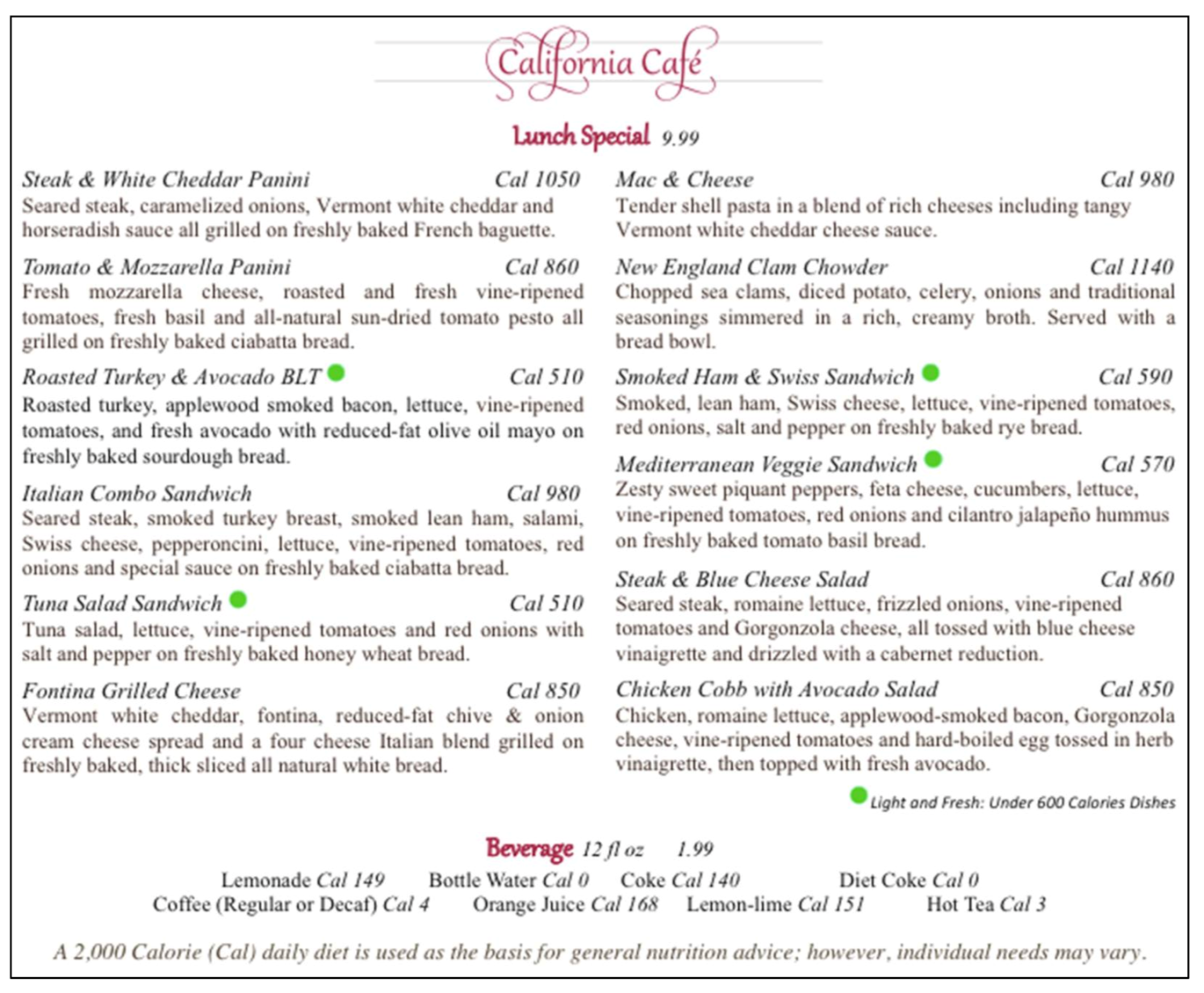
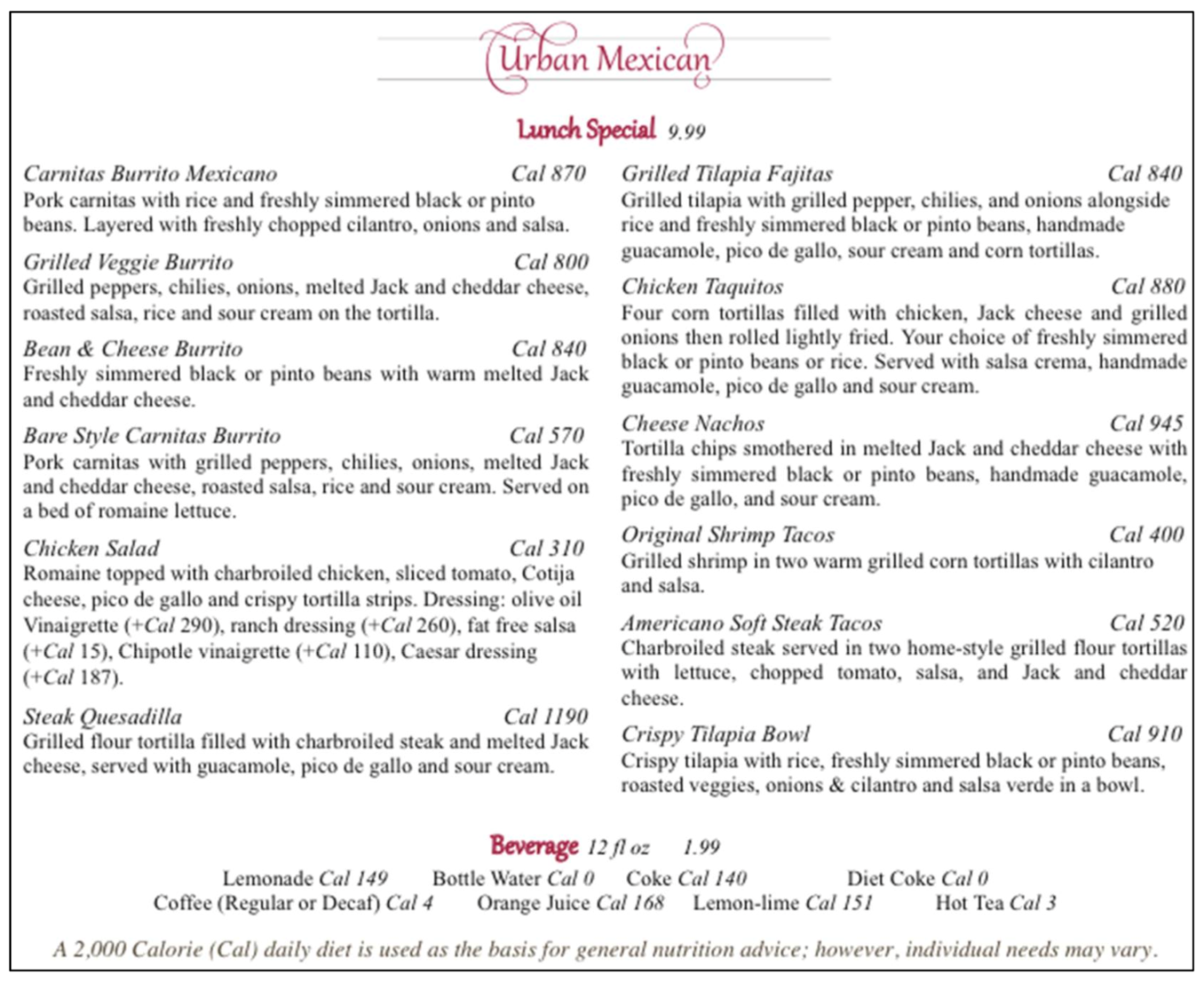
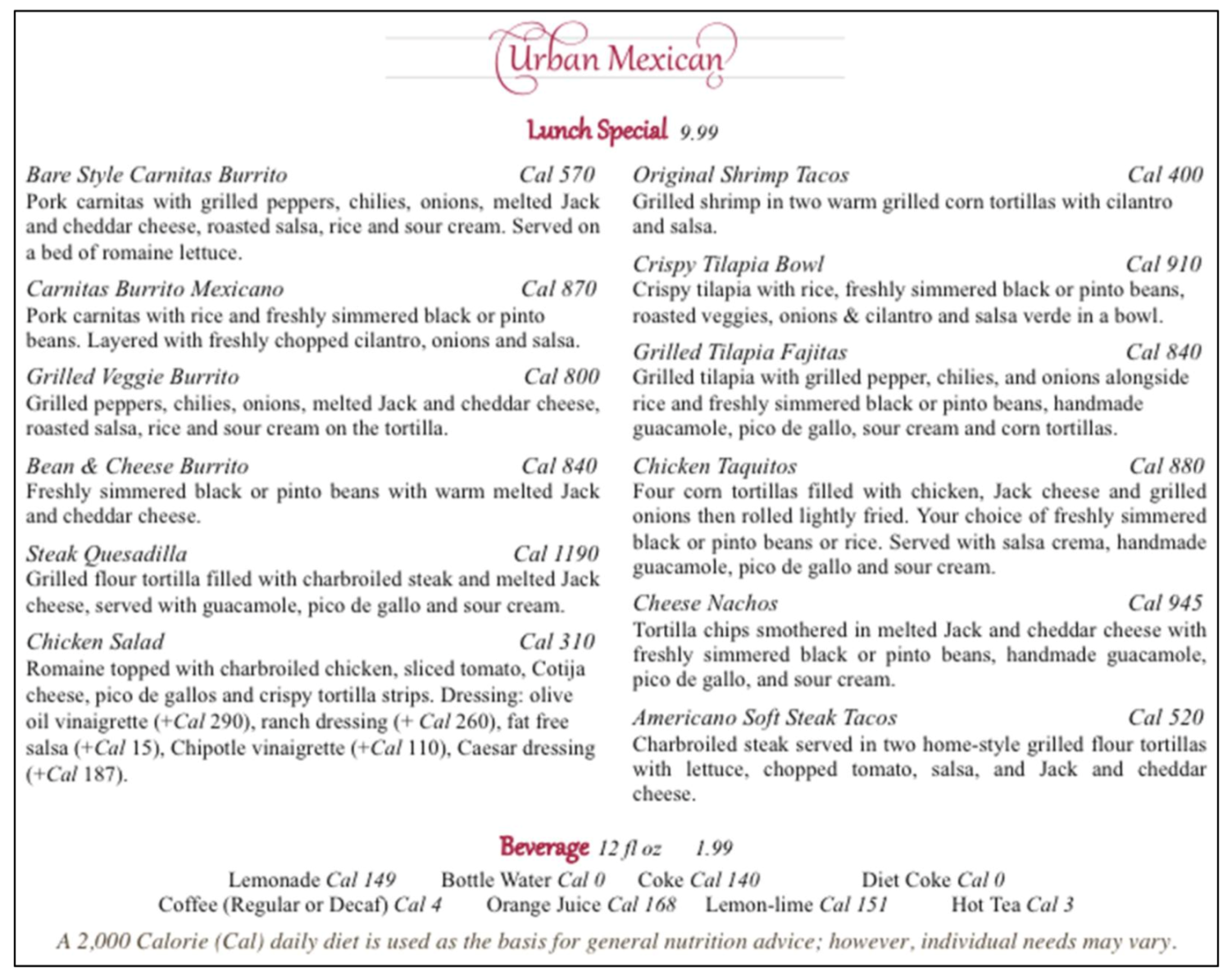


References
- World Health Organization. Obesity and Overweight. Available online: https://www.who.int/news-room/fact-sheets/detail/obesity-and-overweight (accessed on 15 March 2020).
- McKinsey Global Institute. Overcoming Obesity: An Initial Economic Analysis. Available online: https://www.mckinsey.com/~/media/mckinsey/business%20functions/economic%20studies%20temp/our%20insights/how%20the%20world%20could%20better%20fight%20obesity/mgi_overcoming_obesity_full_report.ashx (accessed on 15 March 2020).
- World Health Organization. Global Health Observatory (GHO) Data. Top Causes of Death. Available online: https://www.who.int/gho/mortality_burden_disease/causes_death/top_10/en/ (accessed on 15 March 2020).
- Milken Institute. Economic Impact of Excess Weight Now Exceeds $1.7 Trillion: Costs Include $1.24 Trillion in Lost Productivity, According to Study Documenting Role of Obesity and Overweight in Chronic Diseases. Available online: https://www.sciencedaily.com/releases/2018/10/181030163458.htm#:~:text=of%20chronic%20diseases.-,The%20impact%20of%20obesity%20and%20overweight%20on%20the%20U.S.%20economy,and%20cost%20of%20chronic%20diseases (accessed on 15 March 2020).
- Diliberti, N.; Bordi, P.L.; Conklin, M.T.; Roe, L.S.; Rolls, B.J. Increased portion size leads to increased energy intake in a restaurant meal. Obes. Res. 2004, 12, 562–568. [Google Scholar] [CrossRef] [PubMed]
- Guthrie, J.F.; Lin, B.H.; Frazao, E. Role of food prepared away from home in the American diet, 1977–1978 versus 1994–1997: Changes and consequences. J. Nutr. Educ. Behav. 2005, 34, 140–150. [Google Scholar] [CrossRef]
- Young, L.R.; Nestle, M. The contribution of expanding portion sizes to the US obesity epidemic. Am. J. Public Health 2002, 92, 246–249. [Google Scholar] [CrossRef]
- Morrison, R.M.; Mancino, L.; Variyam, J.N. Will Calorie Labeling in Restaurants Make a Difference. In Amber Waves: The Economics of Food, Farming, Natural Resources, & Rural America; University of California Libraries: Los Angeles, CA, USA, 2011; Volume 9, pp. 10–17. [Google Scholar]
- McGuire, S.; Todd, J.E.; Mancino, L.; Lin, B.-H. The impact of food away from home on adult diet quality. ERR-90, U.S. Department of Agriculture, Econ. Res. Serv., February 2010. Adv. Nutr. 2011, 2, 442–443. [Google Scholar] [CrossRef] [PubMed]
- American Farm Bureau Federation U.S. Food Expenditures at Home and Abroad. Available online: https://www.fb.org/market-intel/u.s.-food-expenditures-at-home-and-abroad (accessed on 11 November 2020).
- Nielsen. What’s in Our Food and on Our Mind: Ingredient and Dining-Out Trends around the World. Available online: https://www.nielsen.com/wp-content/uploads/sites/3/2019/04/global-ingredient-and-out-of-home-dining-trends-aug-2016.pdf (accessed on 11 November 2020).
- Hawk, W. Expenditures of Urban and Rural Households in 2011. Beyond Numbers Prices Spend 2013, 2. Available online: https://www.bls.gov/opub/btn/volume-2/expenditures-of-urban-and-rural-households-in-2011.htm (accessed on 11 November 2020).
- United Nations Economic and Social Council. Sustainable Cities, Human Mobility and International Migration. Available online: https://undocs.org/E/CN.9/2018/2 (accessed on 11 November 2020).
- Meldrum, D.R.; Morris, M.A.; Gambone, J.C. Obesity pandemic: Causes, consequences, and solutions-but do we have the will? Fertil. Steril. 2017, 107, 833–839. [Google Scholar] [CrossRef]
- Rincón-Gallardo Patiño, S.; Zhou, M.; Da Silva Gomes, F.; Lemaire, R.; Hedrick, V.; Serrano, E.; Kraak, V.I. Effects of Menu Labeling Policies on Transnational Restaurant Chains to Promote a Healthy Diet: A Scoping Review to Inform Policy and Research. Nutrients 2020, 12, 1544. [Google Scholar] [CrossRef]
- Crockett, R.A.; E King, S.; Marteau, T.M.; Prevost, T.; Bignardi, G.; Roberts, N.W.; Stubbs, B.; Hollands, G.J.; Jebb, S.A. Nutritional labelling for healthier food or non-alcoholic drink purchasing and consumption. Cochrane Database Syst Rev. 2018, 2, CD009315. [Google Scholar] [CrossRef]
- Fernandes, A.C.; Oliveira, R.C.; Proença, R.P.; Curioni, C.C.; Rodrigues, V.M.; Fiates, G.M. Influence of menu labeling on food choices in real-life settings: A systematic review. Nutr. Rev. 2016, 74, 534–548. [Google Scholar] [CrossRef]
- Littlewood, J.A.; Lourenço, S.; Iversen, C.L.; Hansen, G.L. Menu labelling is effective in reducing energy ordered and consumed: A systematic review and meta-analysis of recent studies. Public Health Nutr. 2016, 19, 2106–2121. [Google Scholar] [CrossRef]
- Sarink, D.; Peeters, A.; Freak-Poli, R.; Beauchamp, A.; Woods, J.; Ball, K.; Backholer, K. The impact of menu energy labelling across socioeconomic groups: A systematic review. Appetite 2016, 99, 59–75. [Google Scholar] [CrossRef]
- VanEpps, E.M.; Roberto, C.A.; Park, S.; Economos, C.D.; Bleich, S.N. Restaurant menu labeling policy: Review of evidence and controversies. Curr. Obes. Rep. 2016, 5, 72–80. [Google Scholar] [CrossRef]
- Cantu-Jungles, T.M.; McCormack, L.A.; Slaven, J.E.; Slebodnik, M.; Eicher-Miller, H.A. A Meta-analysis to determine the impact of restaurant menu labeling on calories and nutrients (ordered or consumed) in U.S. adults. Nutrients 2017, 9, 1088. [Google Scholar] [CrossRef]
- Seaberg, A.G. Menu Design: Merchandising and Marketing; Van Nostrand Reinhold: New York, NY, USA, 1971. [Google Scholar]
- Pavesic, D. The psychology of menu design: Reinvent your ‘silent salesperson’ to increase check averages and guest loyalty. Hosp. Fac. Publ. 2005, 5, 37–43. Available online: https://scholarworks.gsu.edu/hospitality_facpub/5 (accessed on 11 November 2020).
- Robertson, D.; Lunn, P. The Effect of Spatial Position of Calorie Information on Choice, Consumption and Attention. Economic & Social Research Institute Working Paper. 2019. Available online: https://www.esri.ie/publications/the-effect-of-spatial-position-of-calorie-information-on-choice-consumption-and (accessed on 11 November 2020).
- Ellison, B.; Lusk, J.L.; Davis, D. The impact of restaurant calorie labels on food choice: Results from a field experiment. Econ. Inq. 2014, 52, 666–681. [Google Scholar] [CrossRef]
- Sinclair, S.E.; Cooper, M.; Mansfield, E.D. The influence of menu labeling on calories selected or consumed: A systematic review and meta-analysis. J. Acad. Nutr. Diet. 2014, 114, 1375–1388. [Google Scholar] [CrossRef]
- Peduzzi, P.; Concato, J.; Kemper, E.; Holford, T.R.; Feinstein, A.R. A simulation study of the number of events per variable in logistic regression analysis. J. Clin. Epidemiol. 1996, 49, 1373–1379. [Google Scholar] [CrossRef]
- FDA. FDA’s Implementation of Menu Labeling Moving Forward. Fact Sheet USDA Food & Drug Administration; 2019. Available online: https://www.fda.gov/food/food-labeling-nutrition/fdas-implementation-menu-labeling-moving-forward (accessed on 15 June 2021).
- Bar-Hillel, M.; Dayan, E. Nudge to obesity II: Menu positions influence food orders. Judgm. Decis. Mak. 2011, 6, 333–342. [Google Scholar]
- Gallup Organization. Through the eyes of the costumer. Gallup Mon. Rep. Eat. Out 1987, 7, 1–9. [Google Scholar]
- Zwicky, A.D.; Zwicky, A.M. America’s national dish: The style of restaurant menus. Am. Speech 1980, 55, 83–92. [Google Scholar] [CrossRef]
- Prochaska, J.O.; Redding, C.A.; Evers, K. The Transtheoretical Model and Stages of Change. In Health Behavior and Health Education: Theory, Research, and Practice, 3rd ed.; Glanz, K., Rimer, B.K., Lewis, F.M., Eds.; Jossey-Bass Publishers: San Francisco, CA, USA, 2002. [Google Scholar]
- Curry, S.J.; Kristal, A.R.; Bowen, D.J. An application of the stage model of behavior change to dietary fat reduction. Health Educ. Res. 1992, 7, 97–105. [Google Scholar] [CrossRef] [PubMed]
- Glanz, K.; Patterson, R.E.; Kristal, A.R.; DiClemente, C.C.; Heimendinger, J.; Linnan, L.; McLerran, D.F. Stages of change in adopting healthy diets: Fat, fiber, and correlates of nutrient. Health Educ. Q. 1994, 21, 499–519. [Google Scholar] [CrossRef]
- Cox, D.R. The regression analysis of binary responses (with discussion). J. R. Stat. Soc. 1958, 20, 215–242. [Google Scholar]
- Zhang, Z. Model building strategy for logistic regression: Purposeful selection. Ann. Transl. Med. 2016, 4, 111. [Google Scholar] [CrossRef] [PubMed]
- Senaviratna, N.A.M.R.; Cooray, T.M.J.A. Diagnosing multicollinearity of logistic regression model. Asian J. Probab. Stat. 2019, 5, 1–9. [Google Scholar] [CrossRef]
- Quick Facts. United States Census Bureau. 2010. Available online: https://www.census.gov/quickfacts/fact/table/US/POP010210#POP010210 (accessed on 15 June 2021).
- Vanepps, E.M.; Downs, J.S.; Loewenstein, G. Calorie Label Formats: Using Numeric and Traffic Light Calorie Labels to Reduce Lunch Calories. J. Public Policy Mark. 2016, 35, 26–36. [Google Scholar] [CrossRef]
- Yan, S.S. Eye movement on restaurant menus: A revisitation on gaze motion and consumer scanpaths. Int. J. Hosp. Manag. 2012, 3, 11021–11029. [Google Scholar]
- Larson, N.; Haynos, A.; Loth, K.; Neumark-Sztainer, D. Calorie labels on the restaurant menu: Weight-control behaviors and ordering decisions of young adults. J. Nutr. Educ. Behav. 2016, 48, S6–S7. [Google Scholar] [CrossRef]
- Lee, H.; Lee, D.; Guo, G.; Harris, K.M. Trends in body mass index in adolescence and young adulthood in the United States: 1959–2002. J. Adolesc. Health 2011, 49, 601–608. [Google Scholar] [CrossRef][Green Version]
- Walsh, J.; Byrd-Bredbenner, C.; Esters, O.; Greene, G.; Hoerr, S.; Kattelmann, K.; Morrell, J.; Nitzke, S.; Phillips, B.; Shelnutt, K.; et al. Eating behavior and perceptions of young adults in two stages of readiness to eat fruits and vegetables. J. Nutr. Educ. Behav. 2010, 42, S105–S106. [Google Scholar] [CrossRef]
- Park, A.; Nitzke, S.; Kritsch, K.; Kattelmann, K.; White, A.; Boeckner, L.; Lohse, B.; Hoerr, S.; Greene, G.; Zhang, Z. Internet-based interventions have potential to affect short-term mediators and indicators of dietary behavior of young adults. J. Nutr. Educ. Behav. 2008, 40, 288–297. [Google Scholar] [CrossRef]
- Nour, M.; Lutze, S.A.; Grech, A.; Allman-Farinelli, M. The Relationship between Vegetable Intake and Weight Outcomes: A Systematic Review of Cohort Studies. Nutrients 2018, 10, 1626. [Google Scholar] [CrossRef]
- Ellison, B.; Lusk, J.L.; Davis, D. Looking at the label and beyond: The effects of calorie labels, health consciousness, and demographics on caloric intake in restaurants. Int J. Behav. Nutr. Phys. Act. 2013, 10, 21. [Google Scholar] [CrossRef]
- Shangguan, S.; Afshin, A.; Shulkin, M.; Ma, W.; Marsden, D.; Smith, J.; Saheb-Kashaf, M.; Shi, P.; Micha, R.; Imamur, F.; et al. A Meta-Analysis of Food Labeling Effects on Consumer Diet Behaviors and Industry Practices. Am. J. Prev. Med. 2019, 56, 300–314. [Google Scholar] [CrossRef]
- Reale, S.; Flint, S.W. Menu labelling and food choice in obese adults: A feasibility study. BMC Obes. 2016, 3, 1–9. [Google Scholar] [CrossRef]
- Lillico, H.G.; Hanning, R.; Findlay, S.; Hammond, D. The effects of calorie labels on those at high-risk of eating pathologies: A pre-post intervention study in a University cafeteria. Public Health 2015, 129, 732–739. [Google Scholar] [CrossRef]
- Benelam, B. Satiation, satiety and their effects on eating behaviour. Nutr. Bull. 2009, 34, 126–173. [Google Scholar] [CrossRef]
- U.S. Centers for Disease Control and Prevention. About BMI for Adults. Available online: http://www.cdc.gov/healthyweight/assessing/bmi/adult_bmi/ (accessed on 15 June 2021).
| Stage of Change | Question Answers |
|---|---|
| 1. Pre-contemplation | Participants are not currently limiting their calorie amount in their diets, and did not think about it over the past month. |
| 2. Contemplation | Participants are not currently limiting their calorie amount in their diets, but are thinking about it and have a little confidence in changing their current diet in the next month. |
| 3. Preparation | Participants are not currently limiting their calorie amount in their diets, but are thinking about it and are somewhat confident in their ability to start to control their diet in the next month. |
| 4. Action | Participants are currently limiting their calories in their diets, and have been doing so for less than 6 months. |
| 5. Maintenance | Participants are currently limiting their calories in their diets, and have been doing so for at least 6 months. |
| Responses | n | % | |
|---|---|---|---|
| Gender | Male | 272 | 57.7 |
| Female | 194 | 41.2 | |
| Other | 5 | 1.1 | |
| Race/Ethnicity | Asian | 62 | 13.2 |
| African American or Black | 34 | 7.2 | |
| Hispanic or Latino | 35 | 7.4 | |
| Multiracial | 23 | 4.9 | |
| Native American or American Indian | 2 | 0.4 | |
| White | 315 | 66.9 | |
| Education | High school or equivalent | 67 | 14.2 |
| Some college credit, no degree | 147 | 31.2 | |
| Vocational training/technical school | 11 | 2.3 | |
| Associate degree | 68 | 14.4 | |
| Bachelor’s degree | 161 | 34.2 | |
| Master’s degree | 17 | 3.6 | |
| BMI | Underweight | 23 | 4.9 |
| Normal | 266 | 56.5 | |
| Overweight | 114 | 24.2 | |
| Obese | 68 | 14.4 |
| Menu Type | n | % | |
|---|---|---|---|
| Urban Mexican | Control Menu | 55 | 11.7 |
| First and Last a | 53 | 11.3 | |
| Light and Fresh b | 54 | 11.5 | |
| Sweet Spot c | 51 | 10.8 | |
| Total | 213 | 45.2 | |
| Asian Fusion | Control Menu | 40 | 8.5 |
| First and Last | 39 | 8.3 | |
| Light and Fresh | 37 | 7.9 | |
| Sweet Spot | 37 | 7.9 | |
| Total | 153 | 32.5 | |
| California Cafe | Control Menu | 28 | 5.9 |
| First and Last | 23 | 4.9 | |
| Light and Fresh | 28 | 5.9 | |
| Sweet Spot | 26 | 5.5 | |
| Total | 105 | 22.3 |
| Independent Variable | N | Total | % | ||
|---|---|---|---|---|---|
| <600 Calories | ≥600 Calories | <600 Calories | |||
| Restaurant Type | Menu Type | ||||
| Urban Mexican | Control Menu | 15 | 40 | 55 | 27.3 |
| First and Last | 19 | 34 | 53 | 35.8 | |
| Light and Fresh | 27 | 27 | 54 | 50 | |
| Sweet Spot | 12 | 39 | 51 | 23.5 | |
| Total | 73 | 140 | 213 | 34.3 | |
| Asian Fusion | Control Menu | 10 | 30 | 40 | 25 |
| First and Last | 15 | 24 | 39 | 38.5 | |
| Light and Fresh | 10 | 27 | 37 | 27 | |
| Sweet Spot | 15 | 22 | 37 | 40.5 | |
| Total | 50 | 103 | 153 | 32.7 | |
| California Cafe | Control Menu | 13 | 15 | 28 | 46.4 |
| First and Last | 6 | 17 | 23 | 26.1 | |
| Light and Fresh | 15 | 13 | 28 | 53.5 | |
| Sweet Spot | 14 | 12 | 26 | 53.8 | |
| Total | 48 | 57 | 105 | 45.7 | |
| Stage of Change | Pre-contemplation | 68 | 158 | 226 | 30.1 |
| Contemplation | 12 | 21 | 33 | 36.4 | |
| Preparation | 32 | 53 | 85 | 37.6 | |
| Action | 41 | 44 | 85 | 48.2 | |
| Maintenance | 18 | 24 | 42 | 42.9 | |
| BMI | Underweight | 14 | 9 | 23 | 60.9 |
| Normal | 92 | 174 | 266 | 36.7 | |
| Overweight | 38 | 76 | 114 | 33.3 | |
| Obese | 27 | 41 | 68 | 39.7 | |
| Sex | Female | 89 | 105 | 194 | 45.9 |
| Male | 82 | 190 | 272 | 30.1 | |
| Others | 0 | 5 | 5 | 0 | |
| Education | High school | 23 | 44 | 67 | 34.3 |
| Some college credit | 45 | 102 | 147 | 30.6 | |
| Vocational training/technical school | 5 | 6 | 11 | 45.5 | |
| Associate degree | 26 | 42 | 68 | 38.2 | |
| Bachelor’s degree | 63 | 98 | 161 | 39.1 | |
| Master’s degree | 9 | 8 | 17 | 52.9 | |
| Race/Ethnicity | Asian | 20 | 42 | 62 | 32.3 |
| Black/African American | 11 | 23 | 34 | 32.4 | |
| Hispanic/Latino | 13 | 22 | 35 | 37.1 | |
| Multiracial | 11 | 12 | 23 | 47.8 | |
| Native American or American Indian | 0 | 2 | 2 | 0 | |
| White | 116 | 199 | 315 | 36.8 | |
| I Am Hungry Right Now | Strongly Disagree | 15 | 30 | 45 | 33.3 |
| Disagree | 50 | 96 | 146 | 34.2 | |
| Neither Agree nor Disgree | 63 | 108 | 171 | 36.8 | |
| Agree | 20 | 32 | 52 | 38.5 | |
| Strongly Agree | 23 | 34 | 57 | 40.3 | |
| Total Subjects | 171 | 300 | 471 | ||
| B | Df | Sig. | Exp(B) | |
|---|---|---|---|---|
| Menu Design a | 3 | 0.138 | ||
| First and Last | 0.038 | 1 | 0.896 | 1.039 |
| Light and Fresh | 0.594 | 1 | 0.036 | 1.811 |
| Sweet Spot | 0.244 | 1 | 0.396 | 1.276 |
| Stage of Change b | 4 | 0.034 | ||
| From Stage 1 to 2 | 0.440 | 1 | 0.287 | 1.552 |
| From Stage 2 to 3 | 0.118 | 1 | 0.703 | 1.126 |
| From Stage 3 to 4 | 0.649 | 1 | 0.019 | 1.913 |
| From Stage 4 to 5 | −0.038 | 1 | 0.913 | 0.962 |
| Sex a | 2 | 0.015 | ||
| Female to Male | 0.604 | 1 | 0.004 | 1.830 |
| Other to Male | −20.208 | 1 | 0.999 | 0.000 |
| Body Mass Index b | 3 | 0.132 | ||
| Underweight to Normal | −1.032 | 1 | 0.024 | 0.356 |
| Normal to Overweight | −0.623 | 1 | 0.054 | 0.537 |
| Overweight to Obese | −0.218 | 1 | 0.486 | 0.804 |
| Constant | −7.027 | 1 | 0.999 | 0.001 |
Publisher’s Note: MDPI stays neutral with regard to jurisdictional claims in published maps and institutional affiliations. |
© 2021 by the authors. Licensee MDPI, Basel, Switzerland. This article is an open access article distributed under the terms and conditions of the Creative Commons Attribution (CC BY) license (https://creativecommons.org/licenses/by/4.0/).
Share and Cite
Bergman, C.; Tian, Y.; Moreo, A.; Raab, C. Menu Engineering and Dietary Behavior Impact on Young Adults’ Kilocalorie Choice. Nutrients 2021, 13, 2329. https://doi.org/10.3390/nu13072329
Bergman C, Tian Y, Moreo A, Raab C. Menu Engineering and Dietary Behavior Impact on Young Adults’ Kilocalorie Choice. Nutrients. 2021; 13(7):2329. https://doi.org/10.3390/nu13072329
Chicago/Turabian StyleBergman, Christine, Yuan Tian, Andrew Moreo, and Carola Raab. 2021. "Menu Engineering and Dietary Behavior Impact on Young Adults’ Kilocalorie Choice" Nutrients 13, no. 7: 2329. https://doi.org/10.3390/nu13072329
APA StyleBergman, C., Tian, Y., Moreo, A., & Raab, C. (2021). Menu Engineering and Dietary Behavior Impact on Young Adults’ Kilocalorie Choice. Nutrients, 13(7), 2329. https://doi.org/10.3390/nu13072329






